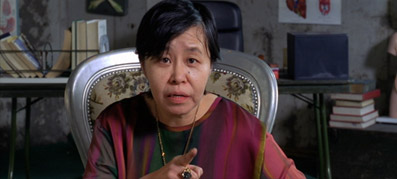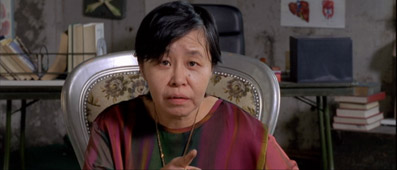|
I first reviewed the first of Park Chan-wook's Vengeance
Trilogy when I covered the release of Tartan's Collector's
Edition of the film back in April 2005, and my views on
the film still stand, so if you want to read my views on the film
itself then follow this link
to the original review. What I intend to cover here are
the differences between the that release and the one in The Vengeance Trilogy box set, notably the new
transfer and the additional extra features.
The
other two films in the set – Oldboy
and Lady Vengeance
– can be accessed through the highlighed links.
The
box blurb assures us that the film has been digitally remastered
for this release, and there is clear evidence that this
is the case. For a start, the Collector's Edition featured
an NTSC to PAL transfer – albeit a very good one from an
excellent original – whereas here we have a proper PAL transfer,
signified instantly by the shorter running time due to PAL
speedup. The difference in picture quality is not as dramatic
as you might think, in the main because the original transfer
was so good, but there's no doubt that on close
examination the new transfer does have the edge in sharpness
and a lack of any motion blurring.
But
there is another interesting aspect to this new transfer.
When I reviewed the Collector's Edition I had some niggling
doubts about the framing, believing that the picture looked
uncomfortably cropped in places. I have since learned that
the film was shot on Super-35, a non-anamorphic method of
producing a scope picture, or indeed a picture in a variety
of aspect ratios. Unless a technique known as 3-perf negative
pulldown is used at the shooting stage, the image area captured
is actually greater than that which is transferred to the
anamorphic projection print, which does allow for a degree
of reframing at the printing stage. It is clear that Mr.
Vengeance was shot on open matte Super-35 but with
2.35:1 as the intended final aspect ratio – on the accompanying
documentaries, the use of scope frame is discussed more
than once, but extracts of the film often appear in open
matte format at approximately 1.85:1. In at least one shot
there is most definitely more picture information than on
the release print.
Given
that scope was always the intended ratio, the 2.35:1 framing
both on the Collector's Edition and this release are correct,
but the two transfers actually differ in the picture
information included. Compare the examples below:
The
top pictures are from the Collector's Edition, with
the remastered
print from the Vengeance Trilogy
Box Set immediately below |
 |
 |
 |
 |
The
top of frame cropping of the earlier release appears to
have been largely corrected here, but in the process we
appear to have lost information at the bottom, although
if the aspect ratio is to be maintained this is somewhat
inevitable. The new framing does generally feel more comfortable,
and indeed makes more sense in some cases – almost all of
the writing on the organ trading sticker Ryu sees on the
toilet was can now be read. Slightly more unexpected is
the loss of picture information at the sides. It's not much,
but is clearly visible on the grabs above.
The
other difference between the two is the colour timing, and
although blame for this can be pointed at the NTSC to PAL
transfer on the earlier release, I can't help wondering
if that was perhaps the more accurately timed of the two
– Park and his crew talk on the extras of the importance
of green to the look of the film, and the new transfer appears
to have toned that down.
As
for the soundtracks – the same three Korean tracks found
on the Collector's Edition are reproduced here and are as
impressive as they were, but not altered in any obvious
fashion.
Director's Commentary
The apostrophe
in the title of this extra should really be moved one character to the right, as there
are actually two directors on board here. This is the same commentary
as can be found on the original release, and you can check
my comments on it by accessing that review.
Jonathan
Ross on Park Chan-wook (16:55)
An extract from one of Ross's film-based TV shows. How you
react to this may depend on your feelings about Mr. Ross,
but it does serve as a useful and heartfelt introduction
to Park's work, includes an interview with Park, and covers
Joint Security Area in reasonable depth.
Ross's complaint that modern American films tend to "tell
the audience what's going to happen, show it happening,
then tell them what just happened," strikes me as right
on the nose. I'd advise not watching this just before either Sympathy for Mr. Vengeance or Oldboy,
however, as it contains spoilers for both.
The
Process of Mr. Vengeance (32:06)
At first glance this appears to be a dressed-up version
of the behind-the-scenes documentary on the Collector's
Edition release, but in fact is more of a companion piece,
drawing on similar source footage shot during the making
of the film but different enough in content to still be
of considerable interest. As before, the behind-the-scenes
footage is intercut with on-set and on-location interviews,
which tend to be longer than those on the previous documentary,
and the make-up effects are covered in more detail. Extracts
from the film (including those playing on the monitor behind
Park Chan-wook when he is interviewed) are framed 1.85:1,
and the autopsy cut that I thought pointed to framing issues
on the original transfer is shown with no cut-off at all.
Oddly, the documentary doesn't end so much as fade out mid-sentence
My Boksu Story (17:23)
A series of retrospective interviews in which cast members Song
Kang-ho, Dae Du-na, Shin Ha-kyun, Lim Ji-eun and young Han
Bo-bae talk discuss roles in the film and recall their the
toughest aspects of the shoot. Song talks about nervousness
over the darker elements of the script and its lack of commercial
success, but all involved appear to hold the film in very
high regard. There's some rather annoying microphone noise
on the exterior interviews, but the sound is otherwise clear.
Crew
Interviews (21:51)
Director Park Chan-wook talks about his intentions for the
film, its look and its characters, and scenes we never saw.
Director of photography Kim Byeong-il reveals the key reason
for using Super-35 instead of anamorphic, while lighting
technician Park Hyon-won chips in to a discussion about
the film's colour scheme. Artistic director Oh Jae-won also
has plenty to say on this and the set design, a subject
also touched on by Park and set decorator Ahn Sung-hyun.
The whole thing is littered with jump-cuts, sometimes in
the middle of sentences.
Storyboards
(9:59)
Shaking off the usual approach of either showing you a gallery
of storyboards or comparing them to the finished film, here
they are rapidly cut together and set to the film's
soundtrack to produce a sort of faux-animated version of
several scenes. Actually rather fascinating, it appears
to have been pulled off low-band tape.
Original Trailer (1:49)
The original Korean trailer, no less, and rather well done.
Definitely
an upgrade from the Collector's edition, largely for the
extra features on disc 2. The reframing gives the actors
a tad more head room (or at least no longer cuts the tops
of their heads off), but in the process we've lost information
at the bottom and sides. As for the colouration
– well, the jury's out on that one.
|